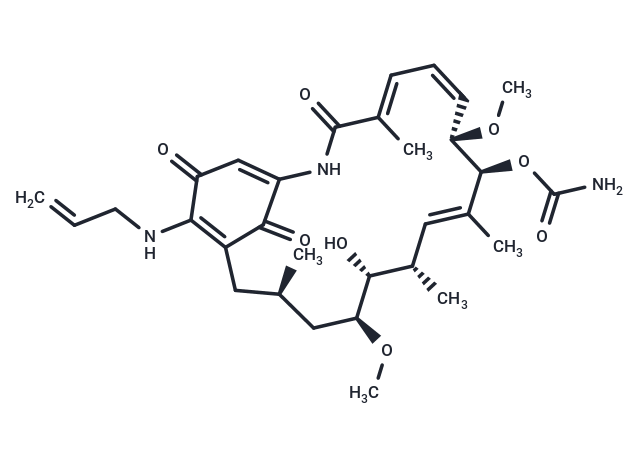Shopping Cart
- Remove All
 Your shopping cart is currently empty
Your shopping cart is currently empty

Tanespimycin (KOS 953) (17-AAG) is an inhibitor of Hsp90 that selectively inhibits BT474 tumor cell Hsp90 (IC50: 5 nM).

| Pack Size | Price | Availability | Quantity |
|---|---|---|---|
| 5 mg | $38 | In Stock | |
| 10 mg | $59 | In Stock | |
| 25 mg | $97 | In Stock | |
| 1 mL x 10 mM (in DMSO) | $54 | In Stock |
| Description | Tanespimycin (KOS 953) (17-AAG) is an inhibitor of Hsp90 that selectively inhibits BT474 tumor cell Hsp90 (IC50: 5 nM). |
| Targets&IC50 | HSP90:5 nM (cell free) |
| In vitro | Hsp90 derived from tumour cells has a 100-fold higher binding affinity for Tanespimycin than does Hsp90 from normal cells. In vitro reconstitution of chaperone complexes with Hsp90 resulted in increased binding affinity to Tanespimycin, and increased ATPase activity [1]. Tanespimycin caused the degradation of HER2, Akt, and both mutant and wild-type AR and the retinoblastoma-dependent G1 growth arrest of prostate cancer cells [2]. Combined Tanespimycin and Trastuzumab treatment of ErbB2-overexpressing breast cancer cell lines leads to enhanced ubiquitinylation, downregulation from the cell surface and lysosomal degradation of ErbB2 [3]. |
| In vivo | At non-toxic doses, Tanespimycin caused a dose-dependent decline in AR, HER2, and Akt expression in prostate cancer xenografts. This decline was rapid, with a 97% loss of HER2 and an 80% loss of AR expression at 4 h [2]. In contrast, spleens from mice which had received Tanespimycin (5 to 40 mg/kg) were dramatically smaller, with less infiltrating lymphoma cells in the spleen, and a lower metastatic spread into other organs, as compared to the vehicle-treated control. In addition, Tanespimycin treated mice survived significantly longer compared to mice which had received vehicle alone [4]. |
| Kinase Assay | Purified native Hsp90 protein or cell lysates in lysis buffer (20 mM HEPES, pH 7.3, 1 mM EDTA, 5 mM MgCl2, 100 mM KCl) were incubated with or without 17-AAG for 30 min at 4 °C, and then incubated with biotin-GM linked to streptavidin magnetic beads for 1 h at 4 °C. Tubes were placed on a magnetic rack, and the unbound supernatant removed. The magnetic beads were washed three times in lysis buffer and heated for 5 min at 95 °C in SDS–PAGE sample buffer. Samples were analyzed on SDS protein gels, and western blots done using indicated antibodies. Bands in the western blots were quantified, and the percentage inhibition of binding of Hsp90 to the biotin-GM was calculated. The IC50 reported is the concentration of 17-AAG needed to cause half-maximal inhibition of binding. For in vitro reconstitution, 5 μM of purified Hsp90 was combined with 1 μM each of Hsp70, Hsp40, p23, and Hop purified proteins [1]. |
| Cell Research | Cells were seeded in 96-well plates at 2,000 cells per well in a final culture volume of 100 μl for 24 h before the addition of increasing concentrations of 17-AAG that was incubated for 5 days. Viable cell number was determined using the Celltiter 96 AQueous Nonradioactive Cell Proliferation Assay. The value of the background absorbance at 490 nm (A490) of wells not containing cells was subtracted. Percentage of viable cells ? (A490 of 17-AAG treated sample/A490 untreated cells) × 100. The IC50 was defined as the concentration that gave rise to 50% viable cell number [1]. |
| Animal Research | B10.BR mice were inoculated with 5×10^5 lymphoma cells through intraperitoneal injection. Seven days following tumor implantation, the mice were I.P. injected with 17-AAG or vehicle (10% DMSO + 40% Cremophor EL: Ethanol (3:1) (v/v) + 50 % PBS) every other day for three weeks. At the cessation of treatment, mice were monitored up to 80 days post tumor cell injection. To determine the effects of 17-AAG on lymphoma initiation in vivo, secondary B10.BR recipient mice were implanted by intraperitoneal injection of 1×10^5 lymphoma cells from the spleens of first-round mice that had been treated with 17-AAG or vehicle. These mice were followed up to 160 days post tumor cell injection to monitor differences in tumor initiation between the mice [4]. |
| Alias | NSC 330507, KOS 953, CP 127374, 17-AAG |
| Molecular Weight | 585.69 |
| Formula | C31H43N3O8 |
| Cas No. | 75747-14-7 |
| Smiles | CO[C@H]1C[C@H](C)CC2=C(NCC=C)C(=O)C=C(NC(=O)\C(C)=C\C=C/[C@H](OC)[C@@H](OC(N)=O)\C(C)=C\[C@H](C)[C@H]1O)C2=O |
| Relative Density. | 1.21 g/cm3 |
| Storage | keep away from direct sunlight,keep away from moisture,store at low temperature | Powder: -20°C for 3 years | In solvent: -80°C for 1 year | Shipping with blue ice. | |||||||||||||||||||||||||
| Solubility Information | DMSO: 22.5 mg/mL (38.42 mM), Sonication is recommended. | |||||||||||||||||||||||||
Solution Preparation Table | ||||||||||||||||||||||||||
DMSO
| ||||||||||||||||||||||||||

Copyright © 2015-2025 TargetMol Chemicals Inc. All Rights Reserved.